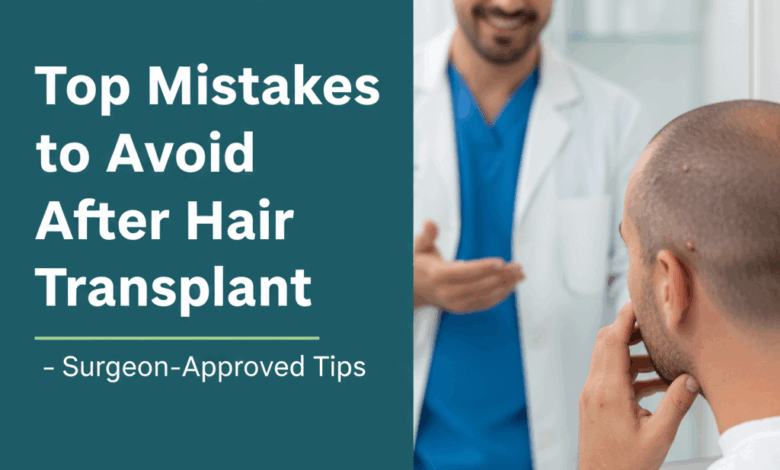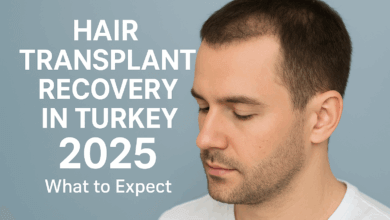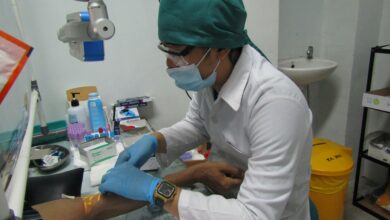Top Mistakes to Avoid After Hair Transplant – Surgeon-Approved Tips
Protect your grafts, prevent complications, and ensure the best results after hair transplant surgery with these expert-backed care tips.

Introduction
A hair transplant is a life-changing procedure — but the final outcome depends heavily on how well you care for your grafts afterward.
Even the most advanced FUE or DHI procedure can fail if post-operative instructions are ignored.
In this guide, our Medsterz experts explain the top mistakes patients make after hair transplant surgery — and how you can avoid them to ensure maximum graft survival and natural results.
1. Touching or Scratching the Scalp
Freshly transplanted grafts are extremely delicate during the first 7–10 days. Touching, rubbing, or scratching the scalp can dislodge grafts or introduce bacteria.
🩺 Expert Tip:
If itching occurs, gently tap (not scratch) the area or use a saline spray or prescribed anti-itch solution from your surgeon.
2. Sleeping Flat or on Your Side
Lying flat increases the risk of swelling and pressure on the grafts.
You should sleep with your head elevated (at 30–45°) using 2–3 pillows or a recliner for the first 5–7 nights.
💡 Proper sleeping position prevents forehead swelling and protects grafts.
3. Washing the Hair Too Early (or Too Roughly)
Washing too soon can wash away grafts, while aggressive scrubbing damages the donor and recipient areas.
Most clinics recommend the first gentle wash after 48–72 hours using lukewarm water and mild shampoo.
🧴 Do: Pour water gently using a cup and pat dry with a soft tissue — never rub.
4. Ignoring Sun Protection
Direct sunlight within the first 2–3 weeks can cause burns, pigment changes, or delayed healing.
Always wear a loose surgical cap or stay indoors during peak hours.
☀️ Avoid: Hats that press tightly on grafts or trap heat.
5. Smoking or Drinking Alcohol
Nicotine and alcohol impair blood circulation, reducing oxygen to transplanted follicles — this can increase graft failure risk.
Avoid both for at least 10–14 days post-surgery.
🩸 Research Insight:
A 2023 Aesthetic Surgery Journal study found smokers had 30% lower graft survival rates compared to non-smokers.
6. Ignoring Surgeon’s Medication Instructions
Skipping antibiotics, anti-inflammatory drugs, or PRP follow-ups can lead to infection and slower healing.
Always complete your prescribed course, even if swelling subsides early.
💊 Expert Note:
Most surgeons recommend PRP sessions within the first 2–3 months to strengthen grafts.
7. Wearing Tight Hats or Helmets
Tight headgear can rub or dislodge grafts in the first 10 days.
Opt for loose, breathable cotton caps — avoid helmets or beanies until your surgeon approves.
8. Doing Heavy Exercise Too Soon
Strenuous activity increases blood pressure and sweating, leading to graft damage or infection.
Avoid gym, swimming, or running for 2–3 weeks.
💧 Why: Excess sweating can delay scab healing and increase infection risk.
9. Picking Scabs or Crusts
Scabs form naturally around grafts during the healing phase. Picking them can pull out grafts prematurely and cause scars.
Allow scabs to fall off naturally within 7–10 days.
10. Skipping Follow-Up Appointments
Many patients skip post-op checkups once initial healing occurs — a critical mistake.
Your surgeon must assess graft survival, growth pattern, and healing progress during the first few months.
📅 Follow-ups ensure early detection of any complications and help optimize results with PRP or medication.
Bonus Tip: Be Patient
New hair growth typically begins 3–4 months after transplant, with visible results in 6–9 months.
Avoid comparing early results or stressing about temporary shedding — known as “shock loss”, it’s completely normal.
Scientific Evidence
-
A 2024 Journal of Dermatologic Surgery report confirmed that postoperative habits like sleeping position, smoking, and premature washing significantly affect graft survival outcomes.
-
Patients following strict aftercare protocols achieved over 95% graft survival within 12 months.
Conclusion
Your surgeon’s job ends in the operating room — but your role begins afterward.
Avoiding these common mistakes ensures your new grafts survive, grow, and deliver the full, natural hairline you’re hoping for.
💬 Final Advice:
Follow your surgeon’s aftercare guide like a prescription — your commitment will decide the final look and density of your hair.





